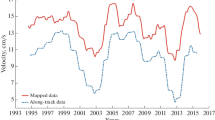Abstract
A study of water circulation in the northwestern part of the Bering Sea using AVISO satellite data on velocities of geostrophic currents from 2002 to 2017 showed a significantly variable dynamics of the surface waters. In January, the main current of the surface waters is directed toward the southwest along the continental slope in contrast to anticyclone water circulation in shelf. In July, the surface water current is oriented to the northeast along the continental slope, whereas cyclonic water circulation is dominant at shelf. The formation of winter mesoscale anticyclones is caused by a gain of low-temperature and low-saline shelf waters. The temporal variability of direction and velocity of summer currents is related to coastal upwelling, which is caused by the southern winds over the western part of the Bering Sea. The presence of upwelling and eddies should be considered one of the factors leading to the formation of an area with high chlorophyll concentration close to the coast during summer.




Similar content being viewed by others
REFERENCES
Ablain, M., Cazenave, A., Larnicol, G., et al., Improved sea level record over the satellite altimetry era (1993–2010) from the Climate Change Initiative project, Ocean Sci., 2015, vol. 11, pp. 67–82.
Andreev, A.G., Mesoscale water circulation in the east Sakhalin current (Sea of Okhotsk), Issled. Zemli Kosmosa, 2017, no. 2, pp. 3–12.
Andreev, A.G., Budyansky, M.V., Uleysky, M.Yu., and Prants, S.V., Mesoscale dynamics and walleye pollock catches in the Navarin canyon area of the Bering Sea, Ocean Dyn., 2018, no. 11, pp. 1503–1514.
Basyuk, E.O., Khen, G.V., and Vanin, N.S., Variability of the oceanological conditions of the Bering Sea in 2002–2006, Izv. Tikhookean. Nauchno-Issled. Inst. Rybn. Khoz. Okeanogr., 2007, vol. 151, pp. 290–311.
Belkin, I.M. and Cornillon, P.C., Bering Sea thermal fronts from Pathfinder data: seasonal and interannual variability, Pacific Oceanogr., 2005, vol. 2, nos. 3–4, pp. 6–20.
Gidrometeorologiya i gidrokhimiya morei. Beringovo more. Gidrometeorologicheskie usloviya (Hydrometeorology and Hydrochemistry of Seas. Bering Sea. Hydrometeorological Conditions), St. Petersburg: Gidrometeoizdat, 1999.
Gidrometeorologiya i gidrokhimiya morei. Beringovo more. Gidrokhimicheskie usloviya i okeanologicheskie osnovy formirovaniya biologicheskoi produktivnosti (Hydrometeorology and Hydrochemistry of Seas. Bering Sea. Hydrochemical Conditions and Oceanological Basis for the Formation of Biological Productivity), St. Petersburg: Gidrometeoizdat, 2001.
Khen, G.V. and Zavolokin, A.V., Changes in water circulation and its importance in the distribution and abundance of salmon in the western part of the Bering Sea in the early 21st century, Izv. Tikhookean. Nauchno-Issled. Inst. Rybn. Khoz. Okeanogr., 2015, vol. 181, pp. 95–115.
Mizobata, K., Wang, J., and Saitoh, S.-I., Eddy-induced crossslope exchange maintaining summer high productivity of the Bering Sea shelf break, J. Geophys. Res.: Oceans, 2006, vol. 111, p. C10 017. https://doi.org/10.1029/2005JC003335
Okkonen, S.R., Schmidt, G., Cokelet, E., and Stabeno, P., Satellite and hydrographic observations of the Bering Sea ‘Green Belt’, Deep-Sea Res. Part II, 2014, vol. 51, pp. 1033–1051. https://doi.org/10.1016/s0967-0645(04)00099-2
Sapozhnikov, V.V., Influence of mesoscale anticyclonic eddies on the formation of the hydrochemical structure of the Bering Sea, Okeanologiya, 1993, vol. 33, no. 3, pp. 347–353.
Stabeno, P.J. and Reed, R.K., Circulation in the Bering Sea basin observed by satellite-tracked drifters: 1986–1993, J. Phys. Oceanogr., 1994, vol. 24, pp. 848–854.
Zhabin, I.A. and Dmitrieva, E.V., Seasonal and interannual variability of wind upwelling off the east coast of Sakhalin island according to the QUIKSCAT satellite SEAWINDS data, Issled. Zemli Kosmosa, 2016, nos. 1–2, pp. 105–115.
Zhabin, I.A., Dmitrieva, E.V., and Vanin, N.S., Influence of wind and ice conditions on upwelling off the west coast of the Kamchatka Peninsula (Sea of Okhotsk) according to satellite observations, Issled. Zemli Kosmosa, 2017, no. 3, pp. 22–28.
Zhurbas, V.M., Stipa, T., Mallki, P., Paka, V.T., Kuz’mina, N.P., and Sklyarov, V.E., Mesoscale upwelling variability in the southeastern Baltic: IR images and numerical simulation, Okeanologiya, 2004, vol. 44, no. 5, pp. 660–669.
Funding
The results of this study were obtained as part of the state budget theme POI FEBRAS, no. 0271-2019-0004. Also this work was supported by the Russian Science Foundation, project no. 19–17-00006.
Author information
Authors and Affiliations
Corresponding author
Additional information
Translated by I. Melekestseva
Rights and permissions
About this article
Cite this article
Andreev, A.G. Circulation of Waters in the Northwestern Part of the Bering Sea According to Satellite Data. Izv. Atmos. Ocean. Phys. 56, 963–969 (2020). https://doi.org/10.1134/S0001433820090029
Received:
Revised:
Accepted:
Published:
Issue Date:
DOI: https://doi.org/10.1134/S0001433820090029




